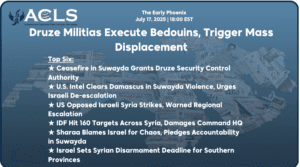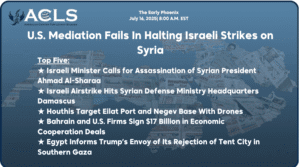Iran and Its Five Proxies Situation Report: Houthi Escalation, Retreats in the Levant
Published on Feb 1, 2024
By: Rania Kisar
January 29, 30, 31 2024
★ IRAN
- Iran Threatens Escalated Attacks on U.S. Troops.
The day following the Iranian government’s denial of involvement in strikes operated by militias in Iraq and Syria which caused the killing of three American officers, Tehran Times released “Crime in Gaza and Punishment in Jordan,” stating that the United States should consider that resistance groups have carried out more than 150 attacks on American forces in the region and should realize that these groups will intensify their retaliation if targeted by the U.S. The article ended with the statement that the entire West Asia region would become “Hell on Earth” for the U.S. In another article on January 30, the same Iranian government led newspaper published explaining Iran’s policy towards American threats in one sentence. “No to war but finger on the trigger.” indicating that President Biden is stuck between “a rock and a hard place”, and noting that the Biden administration is trying to distance itself from pressures on the White House to act. The Iranian authorities in response to Senator Lendsey Graham and Tom Cotton calls for strikes inside Tehran, responded that over 150 attacks on U.S. forces in the region were conducted by resistance groups, warning that these groups would intensify their actions if targeted by the U.S. to distance itself from harsh rhetoric by Congressional Republican leaders and allied hawks who demand the U.S. carry out strikes against Iran. The Iranian regime further explained their positions on Al Jazeera, stating any attack on Iranian territory would cross a red line. Iran emphasized its unwillingness to initiate war but vowed a strong response to any American provocation. Iran referenced its past actions, like the downing of a U.S. drone in June 2019 and missile strikes on Ain al-Asad base in January 2020, as evidence of its defensive capabilities.
- Decline of Iranian Rial Intensifies Economic Crisis and Sparks Widespread Strikes.
The Iranian rial’s decline exacerbates the economic crisis and ignites widespread strikes. Due to a 16% fall in the value of the Iranian rial against the US dollar today, and inflation in Iran nearing 50%, as reported by Iranian newspapers and global economic sources, the official government salary in Iran has decreased by 10%, reaching an equivalent of $180. This amount is $400 less than Iran’s total poverty line, set at $600 per month. In Iran’s Kurdish cities, which are experiencing significant economic deterioration, Ilam Province – one of the majority-Kurdish provinces – recorded an unemployment rate of 6.8% in the spring of 2023, down from 8.1% the previous year. Over the past two years, the proportion of low-income families in Iran has exceeded 22.1% of the total population. Against the backdrop of the Iranian regime’s execution of four civilians, who were arrested in 2022 on charges of collaborating with Israel, ten Kurdish cities in western Iran organized a comprehensive economic strike on January 30. Following this, the regime cut off internet networks, conducted continuous helicopter flights over the area, and the government refused to hand over the bodies of the executed, as their wives pointed out.
=======================
★ YEMEN
- US Bombs Houthi Drone Control Center.
The US Central Command conducted airstrikes targeting a Houthi drone control center and up to ten Houthi drones in Yemen. Additionally, a Houthi missile, deemed a direct threat to US aircraft, was neutralized by US forces on Wednesday.
The Houthi militia confirmed to Al Mayadeen Channel, an Iranian-led Arabic news platform, that 11 raids were conducted. Of these, 9 targeted the Al-Jabbana area in Hodeidah, while 2 raids were directed at northern Saada Governorate. Ali Al-Qahum, a member of the political bureau of Ansar Al-Yemeniya, stated that this operation followed the earlier strikes on Saada.
Consequently, a member of the Political Council of the Yemeni Movement emphasized that their operations continue, reaffirming support for Gaza.
Notably, Yemeni naval forces reported claims that no one heard about targeting the American commercial ship “KOI” headed for Israel, using naval missiles with precise hits, shortly after targeting the American destroyer “USS Greeley” in the Red Sea. At approximately 10:30 a.m. (Sanaa time), the USS Carney engaged an unmanned aerial vehicle and shot it down over the Gulf of Aden. - The Houthis Threaten to Target the Undersea Internet Cables. Affiliated channels on Telegram, including links to Lebanese Hezbollah and Iranian-backed militias in Iraq, published photos of twenty submarine internet cables threatening that these cables will be the Houthis’ next target. These cables are crucial for global digital infrastructure, handling over 95% of international data flows and communications, including significant financial transactions. Damage to these cables could disrupt internet access and economic activities globally and impair military and government communications, especially for the Gulf Cooperation Council states and the U.S. The feasibility of such attacks is highlighted by past incidents, like the 2013 attempt to cut a cable near Alexandria, Egypt.
- Above Water, The Situation Remains Tense. The Houthis have intensified their maritime aggression, targeting both U.S. military and commercial vessels. On Monday morning, the Houthis announced that they fired a missile at the U.S. Buller. This claim was refuted by US Defense officials who explained that the Houthis have previously launched missiles that did not reach their intended target and instead fell on land or sea. Additionally, a British maritime authority announced on Monday that three boats approached a commercial ship 44 miles west of Mokha, one of them carrying a weapon. The ship’s security team fired warning shots to deter the boats, after which the ship safely headed to the nearest port. On Tuesday evening, the Houthis launched an anti-ship cruise missile from their areas of control in Yemen towards the Red Sea. The US destroyer Greeley shot down the missile, and no injuries or damage were reported. In recent weeks, shipping companies have resorted more to using air freight and some customers have begun to ship goods entirely or partially by air to avoid delays. The results are for air freight prices to rise for the first time in seven weeks ahead of the Lunar New Year in Asia, as attacks on cargo ships in the Red Sea prompted companies to resort to more expensive air freight. The Baltic Air Cargo Index, which shows weekly transaction rates for general freight across a number of routes, rose 6.4 percent in the week to Monday. Air freight prices from Shanghai rose 8.8 percent on a weekly basis yesterday, Monday, driven by significant increases to Europe Air freight rates outside Hong Kong also rose 5.9 percent, and air freight rates outside Southeast Asia jumped 10 percent.
- On Ground, The Houthis Escalate Aggression Across Key Yemeni Fronts. The Houthi forces have intensified their military operations across several strategic regions in Yemen. The Yemeni Minister of Information reported that within the last 48 hours, the Houthis have made substantial advances in Taiz, Shabwa, Al-Jawf, and Saada, key areas encompassing the south, east, and north of the country. This offensive includes the mobilization of fighters, vehicles, and ammunition, signaling a deliberate escalation strategy. Notably, the Houthis are leveraging public sentiment around the Palestinian crisis to bolster their ranks and resources. Concurrently, large Houthi reinforcements are moving towards the oil and gas-rich governorates of Marib and Shabwa, intensifying battles in the northern Al-Jawf Governorate. Despite these aggressive maneuvers, the Giants forces, allied with the recognized government, have successfully countered several Houthi attacks, including a significant offensive in the Harib and Bayhan districts of Ma’rib Governorate. The conflict has also seen fierce clashes near the Saudi border, with government forces repelling Houthi attacks in multiple locations in Al-Jawf Governorate. The ongoing violence, marked by mutual artillery shelling, has resulted in casualties and equipment losses on both sides, underlining the escalating tension in the region.
- Houthis Transform Captured Ship into a Tourist Attraction in Yemen. The Houthi rebels in Yemen have converted the “Galaxy Leader” ship, which they have been holding for over two months, into a tourist attraction. This ship, linked to an Israeli businessman, is now a site for Yemenis, especially from Houthi-controlled areas, to visit. The visitors, who come from various parts of Yemen including the capital Sanaa, travel significant distances to see the ship, located off the coast of Al Hudaydah in western Yemen. During these visits, they engage in activities like taking photos and videos, chewing qat (a local stimulant), and performing traditional Yemeni dances to Houthi songs. The ship, owned by a British group affiliated with an Israel-based company, was seized by the Houthis on November 19 as part of their campaign against commercial ships in the Red Sea suspected of being linked to Israel.
=======================
★ IRAQ
- Khamenei Sends Iranian Quds Force Commander to Iraq, Syria, and Lebanon Following U.S. Strike in Jordan. Following the U.S. military strike in Jordan, General Ismail Qaani, leader of the Quds Force in Iran, undertook a secret mission to Baghdad. During his visit, Qaani engaged in discussions with the Iraqi Prime Minister and heads of various armed groups. The meetings supposedly aimed at de-escalating the tension that had risen between the American forces and militias supported by Iran. These talks were conducted in parallel with conversations about the potential conclusion of the international coalition’s mission in Iraq. In the aftermath of Qaani’s visit, Kataib Hezbollah, an Iranian-aligned militia, declared a cessation of its military operations targeting U.S. forces. This decision was described as an effort to avoid putting the Iraqi government in a difficult position. The U.S. Department of Defense, while not commenting directly on these events, highlighted the significance of deeds rather than words. Furthermore, the U.S. Treasury is actively pursuing details from the Iraqi administration regarding the operations of these Iranian-backed entities.
=======================
★ SYRIA
- Russia Offers Citizenship to Foreigners Fighting in Ukraine. Two years into the Russian invasion of Ukraine, Putin has signed a decree that allows foreigners serving in the Russian army to obtain Russian citizenship. This policy has attracted individuals from various countries, including Arab nations, Afghanistan, and India. A young Syrian recruit shared with his family that he received training in weapon handling and basic Russian language skills before he was stationed along the Russian-Ukrainian border within Russian military installations.
- Turkish Forces and ISIS Strike SDF. In the morning hours of Tuesday January 30, Turkish forces targeted six civilian villages north and west of Manbij city in Aleppo. On Tuesday night, ISIS claimed responsibility for several attacks against SDF in the eastern suburbs of Deir Ezzor.
- Israeli Forces Strike Iranian Posts in Daraa, South Syria. In response to the firing of at least three missiles into the Israeli-occupied area of the Golan Heights, Israeli missiles targeted a military site and another near the Yarmouk Basin area.
=======================
★ LEBANON
- Series of Hezbollah Attacks and Israeli Military Responses in Lebanon: January 29-31, 2024. On Monday, Hezbollah claimed responsibility for 12 attacks on Israeli army positions near the border using Iranian-made Falaq 1 missiles. On Monday evening, the Israeli army announced that it had carried out strikes against Hezbollah in response, including against “facilities and an observation point in the Lebanese villages of Markaba, Al-Taybeh and Maroun Al-Ras.” The army also confirmed the launch of several projectiles from Lebanon, noting that it “responded by targeting the launch sites and other sites in Lebanon.” Hezbollah targeted Tuesday a group of soldiers in the Hadb Yarin post. Hezbollah also said it has targeted surveillance equipment near the border village al-Wazzani. The situation further intensified on Wednesday, January 31. The Israeli army reportedly used phosphorus shells in Kafr Kila, while Hezbollah launched attacks against Israeli soldiers and assets, including targeting the “Al-Manara” settlement, the “Jal al-Alam” site with a Falaq 1 missile, and an Israeli Merkava tank at Bayad Blida. Hezbollah also claimed responsibility for bombings targeting Israeli soldier gatherings at Al-Tayhat Hill, Metulla, and the Mitat Barracks. Concurrently, Israeli forces conducted multiple raids on Lebanese towns such as Beit Lev, Blida, and Yaron, resulting in civilian casualties and the targeting of an ambulance. This three-day period demonstrated a severe deterioration in the security environment along the Lebanese border, with both sides actively engaging in military actions and reporting direct hits.
=======================



